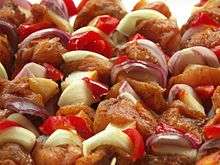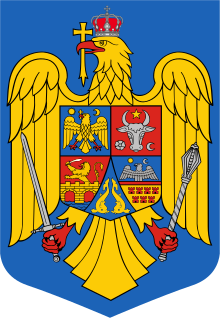Romanian cuisine
Romanian cuisine is a diverse blend of different dishes from several traditions with which it has come into contact, but it also maintains its own character. It has been mainly influenced by Turkish and a series of European cuisines such as the Austrian cuisine, German cuisine, Greek cuisine, or Hungarian cuisine as well as culinary elements stemming from the cuisines of the Slavic-speaking countries of Eastern and Central Europe.
| Part of a series on the |
| Culture of Romania |
|---|
 |
| History |
| People |
| Languages |
|
Mythology and folklore
|
|
Festivals |
|
|
|
Music and performing arts
|
|
Media |
| Sport |
|
Organisations |
|
There are quite a few different types of dishes, which are sometimes included under a generic term; for example, the category ciorbă includes a wide range of soups with a characteristic sour taste. These may be meat and vegetable soups, tripe (ciorbă de burtă) and calf foot soups, or fish soups, all of which are soured by lemon juice, sauerkraut juice, vinegar, or borș (traditionally made from bran). The category țuică (plum brandy) is a name for a strong alcoholic spirit in Romania.
History
In the history of Romanian culinary literature, Costache Negruzzi and Mihail Kogălniceanu were the compilers of a cookbook "200 rețete cercate de bucate, prăjituri și alte trebi gospodărești" (200 tried recipes for dishes, pastries and other household things) printed in 1841.[1] Also, Negruzzi writes in "Alexandru Lăpușneanu": "In Moldavia, at this time, fine food wasn't fashioned. The greatest feast only offered a few types of dishes. After the Polish borș, Greek dishes would follow, boiled with herbs floating in butter, after that, Turkish pilaf, and finally cosmopolitan steaks".[2]
Cheese has been a part of Romanian cuisine since ancient history. Brânză is the generic term for cheese in Romanian; it is originally a Dacian word. Traditional Dacian cuisine included vegetables (lentils, peas, spinach, garlic) and fruits (grapes, apples, raspberries) with high nutritional values.[3] The Dacians produced wine in massive quantities. Once, Burebista, a Dacian king, angered by the wine abuse of his warriors, cut down the vines; his people gave up drinking wine.[4] Legend says that the Dacian people created their own beer. Romans helped introduce different pastries made with cheese, including alivenci, pască, or brânzoaice. They also introduced different variations of millet porridge.
Maize and potatoes became staples of Romanian cuisine after their introduction to Europe. Maize, in particular, contributed to health and nutrition improvements of Romanians in the 16th and 17th centuries, resulting in a population boom.
For more than four centuries, Wallachia and Moldavia, the two medieval Romanian principalities, were strongly influenced by their neighbor, the Ottoman Empire. Ottoman cuisine changed the Romanian table with appetizers made from various vegetables, such as eggplant and bell peppers, as well as various meat preparations, such as chiftele (deep-fried meatballs, a variation of kofta) and mici (short sausages without casings, usually barbecued). The various kinds of ciorbă/borș (sour soups) and meat-and-vegetable stews, such as iahnie de fasole (beans), ardei umpluți (stuffed peppers), and sarmale (stuffed cabbage) are influenced by Turkish cuisine. The Romanian tomato salad is a variation of the Turkish çoban salata. Many traditional desserts and pastries combine honey and nuts, such as baclava, sarailie (or seraigli), halva, and rahat (Turkish delight).
Description
Romanian recipes bear the same influences as the rest of Romanian culture. The Turks brought meatballs (perișoare in a meatball soup), from the Greeks there is musaca, from the Austrians there is the șnițel, and the list could continue. The Romanians share many foods with the Balkan area (in which Turkey was the cultural vehicle), and Eastern Europe (including Moldova and Ukraine). Some others are original or can be traced to the Romans, as well as other ancient civilizations. The lack of written sources in Eastern Europe makes it impossible to determine today the exact origin for most of them.
One of the most common meals is the mămăligă, the precursor of polenta, served on its own or as an accompaniment. Pork is the main meat used in Romanian cuisine, but also beef is consumed and a good lamb or fish dish is never to be refused.
Before Christmas, on December 20 (Ignat's Day or Ignatul in Romanian),[5] a pig is traditionally sacrificed by every rural family.[6] A variety of foods for Christmas are prepared from the slaughtered pig, such as:
- Cârnați – garlicky pork sausages, which may be smoked or dry-cured;
- Lebăr – an emulsified sausage based on liver with the consistency of the filling ranging from fine (pâté) to coarse;
- Sângerete (black pudding) – an emulsified sausage obtained from a mixture of pig's blood with fat and meat, breadcrumbs or other grains, and spices;
- Tobă (head cheese) – based on pig's feet, ears, and meat from the head suspended in aspic and stuffed in the pig's stomach;
- Tochitură – a stew made with pork, smoked and fresh sausage simmered in a tomato sauce and served with mămăligă and wine ("so that the pork can swim"). There are many variations of this stew throughout Romania, with some versions combining different meats, including chicken, lamb, beef, pork and sometimes even offal;
- Pomana porcului—pan-fried cubed pork served right after the pig's sacrifice to thank the relatives and friends who helped with the process;
- Piftie/răcitură – inferior parts of the pig, mainly the tail, feet, and ears, spiced with garlic and served in aspic;
- Jumări – dried pork remaining from rendering of the fat and tumbled through various spices
The Christmas meal is sweetened with the traditional cozonac, a sweet bread made with nuts, poppy seeds, or rahat (Turkish delight).
At Easter, lamb is served: the main dishes are borș de miel (lamb sour soup), roast lamb, and drob de miel – a Romanian-style lamb haggis made from minced offal (heart, liver, lungs), lamb meat and spring onions with spices, wrapped in a caul and roasted.[7][8] The traditional Easter cake is pască, a pie made from yeast dough with a sweet cottage cheese filling at the center.[9][10]
Romanian pancakes, called clătite, are thin (like the French crêpe) and can be prepared with savory or sweet fillings: ground meat, cheese, or jam. Different recipes are prepared depending on the season or the occasion.[11]
Wine is the preferred drink, and Romanian wine has a tradition of over three millennia.[11] Romania is currently the world's ninth largest wine producer, and recently the export market has started to grow.[11] Romania produces a wide selection of domestic varieties (Fetească, Grasă, Tămâioasă, Busuioacă, and Băbească), as well as varieties from across the world (Italian Riesling, Merlot, Sauvignon blanc, Cabernet Sauvignon, Chardonnay, and Muscat Ottonel). Beer is also highly regarded, generally blonde pilsener beer, made with German influences. There are also Romanian breweries with a long tradition.
According to the 2009 data of FAOSTAT, Romania is the world's second largest plum producer (after the United States),[12] and as much as 75% of Romania's plum production is processed into the famous țuică, a plum brandy obtained through one or more distillation steps.[13]
Vegetarianism / Veganism
Followers of the Romanian Orthodox Church keep fast during several periods throughout the ecclesiastical calendar amounting to a majority of the year. In the Romanian Orthodox tradition, devotees keep to a diet without any animal products during these times. As a result, vegan foods are abundant in stores and restaurants; however, Romanians may not be familiar with a vegan or vegetarian diet as a full-time lifestyle choice.[14] Many recipes below have vegan versions, and the Vegetables section below contains many common fasting foods.
List of dishes
Soups
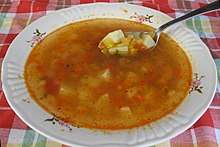
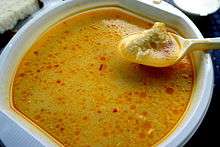
- Borș is fermented wheat bran, a souring agent for ciorbă. Borș is also used today as a synonym for ciorbă, but in the past, a distinction was made between borș and ciorbă (acritură), the souring agent for the latter being the juice of unripe fruits, such as grapes, mirabelle, or wood sorrel leaves.
- Ciorbă is the traditional Romanian sour soup
- Ciorbă de burtă (tripe soup), soured with sour cream
- Ciorbă de perișoare (meatball soup)
- Ciorbă de fasole cu afumătură (bean and smoked meat soup)
- Ciorbă de legume (vegetable soup)
- Ciorbă de pește „ca-n Deltă” (fish soup prepared in the style of the Danube Delta)
- Ciorbă de praz is a leek soup
- Ciorbă de pui is a chicken soup
- Ciorbă de lobodă is a red orach soup
- Ciorbă de salată cu afumătură (green lettuce and smoked meat soup)
- Ciorbă de sfeclă, also called Borș de sfeclă or Borș rusesc (similar to Borscht)
- Ciorbă de urechiușe, wild mushroom sour soup
- Ciorbă moldovenească de găină is a hen sour soup
- Ciorbă țărănească (peasant soup), made from a variety of vegetables and any kind of meat (beef, pork, mutton, chicken, fish)
- Storceag, fish soup with sour cream and egg, soured with vinegar or lemon juice.
- Supă (generic name for sweet (usually clear) soups, made from vegetables alone or combined with poultry and beef). The difference between Supă and Ciorbă is that the meat and most of the vegetables are removed, the resulted liquid being served with dumplings or noodles. There are also a number of sour soups, which use lemon juice as a souring agent, called Supe a la grec (Greek soups).
Meat
- Caltaboș / chișcă - a cooked sausage made from minced pork organs and rice, stuffed in a pig's casing
- Cârnați - a garlicky sausage, as in Fasole cu cârnați
- Chiftele - a type of large meatball covered with breadcrumbs or a flour crust
- Ciulama - white roux sauce used in a variety of meat dishes
- Ciulama de vițel - veal ciulama
- Ciulama de pui - chicken ciulama
- Drob de miel - a lamb haggis made from minced organs wrapped in a caul and roasted like a meatloaf; a traditional Easter dish
- Frigărui - Romanian-style shish-kebab
- Limbă cu măsline - cow tongue with olives
- Mititei (mici) - grilled minced meat rolls
- Grătar (usually made together with "mici") - grilled pork/beef with condiments
- Musaca - an eggplant, potato, and meat pie
- Ostropel - method of cooking chicken or duck
- Papricaș - Chicken paprikash
- Gulaș - Goulash
- Pârjoale - a type of meatball
- Piftie - the preparation of this dish is similar to the French demi-glace. Pork stock is reduced by simmering, which is placed in containers, and spiced with garlic and sweet paprika powder. The boiled pork meat is then added, and left to cool. The cooled liquid has a gelatinous consistency.
- Pleșcoi sausages - registered as a Romanian protected geographical indication (PGI) product in the European Union[15]
- Rasol
- Salam de Sibiu - a variety of salami registered as a Romanian protected geographical indication (PGI) product in the European Union[15]
- Sarmale - minced meat with rice, wrapped in either pickled cabbage leaves or vine leaves
- Slănină - pork fat, often smoked
- Șnițel - a pork, veal, or beef breaded cutlet (a variety of Viennese schnitzel)
- Cordon bleu șnițel - breaded pork tenderloin stuffed with ham and cheese
- Mozaic șnițel - a specialty of Western Romania, which is two thin layers of different meats with a mushroom filling. Other vegetable fillings may be used instead of mushrooms.
- Șnițel de pui - breaded chicken breast cutlet
- Stufat - lamb, onion, and garlic stew
- Tobă - pork sausage (usually pig's stomach, stuffed with pork jelly, liver, and skin)
- Tocană/tocaniță - meat stew
- Tocăniță vânătorească - venison stew
- Tochitură - a Romanian stew made from pan-fried cubed pork, served with mămăligă and wine
- Varză călită - steamed cabbage with pork ribs, duck, or sausages
- Virșli - a type of sausage made from a mixture of goat or lamb with pork
Fish
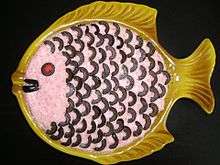
- Chiftele de pește - fish cake
- Crap pane - breaded carp fillet
- Ghiveci cu pește - fish stew with vegetables
- Macrou afumat - smoked mackerel fillet
- Novac afumat din Țara Bârsei - smoked carp fillet, registered as a Romanian protected geographical indication (PGI) product in the European Union[16]
- Pană de somn rasol - catfish in brine with garlic
- Plachie din pește - ragout of river fish with vegetables
- Papricaș de pește - fish papricaș
- Salată de icre - roe salad, traditionally made from carp, pike, or various marine fish species, called tarama, with onion
- Saramură de crap - carp in brine
- Scrumbie de Dunăre afumată - smoked pontic shad, registered as a Romanian protected geographical indication (PGI) product in the European Union[17]
Vegetables
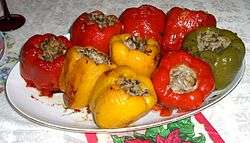
- Ardei umpluți - stuffed bell peppers
- Dovlecei umpluți - stuffed zucchini
- Gulii umplute - stuffed kohlrabi
- Vinete umplute - stuffed eggplant
- Sarmale - stuffed cabbage rolls, also made from grape or dock leaves
- Ghiveci - vegetable stew or cooked vegetable salad, similar to the Bulgarian gjuvec and the Hungarian lecsó[18][19]
- Ghiveci cǎlugăresc - vegetable stew prepared by the nuns in the monasteries
- Iahnie - beans prepared with spices and cooked until there's no more water, forming a soft sticky sauce binding the beans together
- Fasole batută - Romanian refried beans, uses white or Cannellini beans, with the addition of olive or sunflower oil and minced garlic. The dish is traditionally served with fried onions as a garnish.
- Mămăligă - cornmeal mush, also known as Romanian-style polenta. Mămăligă can be served as a side dish or form the basis of further dishes, such as mămăligă cu lapte (polenta with hot milk), bulz (baked polenta with Romanian sheep cheese and sour cream), mămăliguță cu brânză și smântănă (polenta with telemea (Romanian cheese similar to feta) and sour cream), etc.
- Mâncare de mazăre - pea stew
- Mâncare de praz - leek stew
- Pilaf - a dish of rice, vegetables, and pieces of meat (optional). The meat is usually the offal, wings, and organs of chicken, pork, or lamb. The cooking method is very similar to risotto.
- Chifteluțe de ciuperci - chiftele made from mushrooms instead of meat
- Șnițel de ciuperci - mushroom fritter (șnițel is the Romanian spelling of the German word schnitzel (breaded boneless cutlet), but it may be used to mean any sort of fritter)
- Plăcintă aromână - pie with spinach and white cheese
- Tocană de ciuperci - mushroom stew
- Tocăniță de gălbiori - chanterelle stew
- Zacuscă - vegetable spread consisting of roasted eggplant, sauteed onions, tomato paste, and roasted red peppers
List of salads

- Ardei copți - roasted pepper salad, with vinegar and sunflower or olive oil
- Murături - method of pickling different fruits and vegetables
- Castraveți murați - pickled small cucumbers
- Gogonele murate - pickled green tomatoes, which is the simple version of murături asortate
- Varză murată - cabbage pickled in brine, flavored with dill stalks and beetroots for red colour.
- Murături asortate - pickled mixed vegetables; a combination of any of the following: onions, garlic, green tomatoes, peppers, cucumbers, kohlrabi, beets, carrots, celery, parsley roots, cauliflower, apples, quince, unripe plums, small unripe watermelons, small zucchini, and red cabbage. It is most often cured in brine (Turkish version), though it can also be cured in vinegar (German version).
- Mujdei - crushed garlic sauce
- Salată de boeuf - minced meat with boiled vegetables, mayonnaise, and a dash of mustard
- Salată de vinete - roasted and peeled eggplant, chopped onions, and salt mixed with oil or mayonnaise
- Salată orientală - potato salad with eggs, onions, and olives
- Salată de sfeclă - beet salad
- Salată de roșii - tomato salad, with sliced onions, bell peppers, and cucumber. Flavored with dill or parsley.
List of cheeses

The generic name for cheese in Romania is brânză, and it is considered to be of Dacian origin. Most of the cheeses are made from cow's or sheep's milk. Goat's milk is rarely used. Sheep cheese is considered "the real cheese", although in modern times, some people refrain from consuming it due to its higher fat content and specific smell.
- Brânză de burduf is a kneaded cheese prepared from sheep's milk and traditionally stuffed into a sheep's stomach; it has a strong taste and semi-soft texture
- Brânză topită is a melted cheese and a generic name for processed cheese, industrial product
- Brânză în coșuleț is a sheep's milk, kneaded cheese with a strong taste and semi-soft texture, stuffed into bellows of fir tree bark instead of pig bladder, very lightly smoked, traditional product
- Caș is a semi-soft fresh white cheese, unsalted or lightly salted, stored in brine, which is eaten fresh (cannot be preserved), traditional, seasonal product
- Cașcaval is a semi-hard cheese made from sheep's or cow's milk, traditional product. The Cașcaval de Săveni is a type of cașcaval published as a Romanian protected geographical indication (PGI) product in the European Union.[20]
- Penteleu, a type of cașcaval, traditional product
- Năsal cheese is a type of cheese with a pungent aroma, traditional product
- Șvaițer, industrial product ("Schweizer Käse")
- Telemea, cow's or sheep's milk white cheese, vaguely similar to feta. The traditional "Telemea de Ibănești" is a type of telemea registered as a Romanian protected designation of origin (PDO) product in the European Union, while the "Telemea de Sibiu" is registered as a Romanian protected geographical indication (PGI) product in the European Union.[15][20] Notably the "Telemea de Covurlui" is spiced with Nigella damascena seeds, which gives it a unique flavor.
- Urdă - made by boiling the whey drained from cow's or ewe's milk until the remaining proteins precipitate and can be collected, traditional product
- Zămătișe - a type of cottage cheese.
List of desserts
- Alivenci, corn and cheese pie in sweet and salted variants. Traditional dessert in Eastern Romania and Moldova.

- Amandine - chocolate sponge cake with almond and chocolate filling, glazed in chocolate
- Baclava
- Brânzoaice (Poale-n brâu moldovenești) - traditional Moldavian soft cakes filled with sweet cheese[21]
- Chec - pound cake
- Clătite - crêpes (literally: pancakes)
- Colivă - boiled wheat, mixed with sugar and walnuts (often decorated with candy and icing sugar; distributed at funerals and memorial ceremonies)
- Colțunași
- Cornulețe - pastries filled with Turkish delight, jam, chocolate, cinnamon sugar, walnuts, or raisins, with the shape representing a crescent
- Covrigi - pretzel[22]
- Cozonac - a kind of Stollen made from leavened dough, into which milk, eggs, sugar, butter, and other ingredients are mixed together before baking
- Cremă de zahăr ars - Crème brûlée
- Găluști cu prune - dumplings with plums, a dessert made of mashed potatoes and flour dough and filled with fresh plums
- Gogoși - literally "doughnuts", but more akin to fried dough[23]
- Griș cu lapte
- Halva
- Lapte de pasăre - literally "bird's milk", vanilla custard garnished with "floating islands" of whipped egg whites
- Magiun of Topoloveni - a type of plum jam, registered as a Romanian protected geographical indication (PGI) product in the European Union[15]
- Mucenici/sfințișori - sweet pastries (shaped like "8", made from boiled or baked dough, garnished with walnuts, sugar, or honey, eaten on a single day of the year, on 9 March)[24]
- Orez cu lapte - Rice pudding
- Pandișpan - Sponge cake
- Papanași - a kind of doughnut made from a mixture of sweet cheese, eggs, and semolina, boiled or fried and served with fruit syrup or jam and sour cream
- Pelincile Domnului - a Moldavian type of pie made of honey-flavoured thin wheat cakes and hemp seed cream. Less and less exposure because of the confusion between Cannabis sativa (traditionally cultivated in Romania) and Cannabis indica (the THC-rich variety)
- Plăcintă - pie
- Prăjituri - assorted pastries
- Rahat - Turkish delight
- Salam de biscuiți - literally „salami of biscuits", made from biscuits, chocolate, Turkish delight, and rum essence. The cylindrical shape resembles a sausage, hence the name.
- Savarine - savarina[25]
- Scovergi - flat fried dough. It is eaten with honey, jam or cheese.
- Șarlotă - a custard made from milk, eggs, sugar, whipped cream, gelatin, fruits, and ladyfingers; from the French Charlotte
- Tort - cake
- Tort Joffre - Joffre cake - invented at the Casa Capșa restaurant in Bucharest
- Turtă dulce - gingerbread
List of drinks
- Afinată - a liqueur made from afine (aka. bilberry in English), which are similar to the North American blueberry.
- Bere
- Bragă
- Cafea
- Ceai - prepared in the form of either various plant tisanes (chamomile, mint, tilly flower, etc.) or common black tea, called ceai rusesc in Romanian, which is Russian tea usually served during breakfast.
- Horincă is a plum or apple brandy, produced in the northern part of the country (Maramureș)
- Must - the grape juice in the fermentation process that hasn't become wine yet.
- Pălincă is a strong, double-distilled fruit brandy (especially plum, but also apple, apricots, peach, pear etc.) produced in Transylvania
- Pelin de mai is a wine specialty, usually produced in the spring, flavored with Artemisia dried plants
- Rachiu is a fruit brandy. Generic "rachiu" can be made from any fruit (except plums), while "țuică" is reserved exclusively for the variety of brandy made from plums.
- Rachiu de tescovină is a pomace brandy produced from grapes that have been used in wine production, very similar to the Italian grappa
- Sana is a kind of a drinkable yogurt
- Secărică is a caraway fruit flavored vodka, similar to the German kümmel
- Sirop - prepared with syrup made from fir tree, pine, buckthorn, blueberry, raspberry, or strawberry, with different types of honey or sugar
- Socată is a non-alcoholic beverage made from fermented elderflower (Sambucus nigra)
- Șliboviță is a plum brandy, produced in the Banat region.
- Turț is a strong, double-distilled plum brandy, named after the village of Turț in northwestern Romania
- Țuică is a plum brandy
- Vin
- Vișinată is a sour cherry liqueur
- Vodcă
- Zmeurată is a raspberry liqueur
See also
Notes and references
- Bogdan Ulmu: Rețete de la Kogălniceanu & Negruzzi | Bucatarescu
- "Lumea" nr 17,1946,p 1,Art:O carte de bucate, G. Călinescu
- "Alimentația la daci", Dracones.ro
- Strabo, Geography, VII:3.11
- Ignatul or Ignat's Day (December 20)
- Christmas customs in Romania: "pig's ritual sacrifice"
- Making lamb drob
- Traditional recipe for drob de miel, with step-by-step photos
- A photo of pasca
- Pasca recipe
- Educations.com/Study in Romania
- "Final 2009 Data". Food and Agriculture Organization of the United Nations.
- Țuica production consumed 75% of Romanian plums in 2003
- "What Vegan Travelers Need to Know about Dining in Romania". Huffington Post. 2017-02-14. Retrieved 2018-07-30.
- Cârnații de Pleșcoi, al șaselea produs românesc recunoscut și protejat în UE
- "EU reference site". ec.europa.eu.
- Scrumbia afumată de Dunăre, al cincilea produs românesc recunoscut oficial
- Ghiveci: Romanian vegetable stew
- Recipe for ghiveci
- "eAmbrosia – the EU geographical indications register". ec.europa.eu.
- ”Poale-n brâu" history and recipe
- Covrigi on display
- Varieties of gogoși: photos and recipes (in Romanian)
- Mucenici: background and recipe
- Recipe for savarina
Other sources
- Nicolae Klepper, Taste of Romania, Hippocrene, New York, 1999, ISBN 978-0-7818-0766-1, ISBN 0-7818-0766-2
